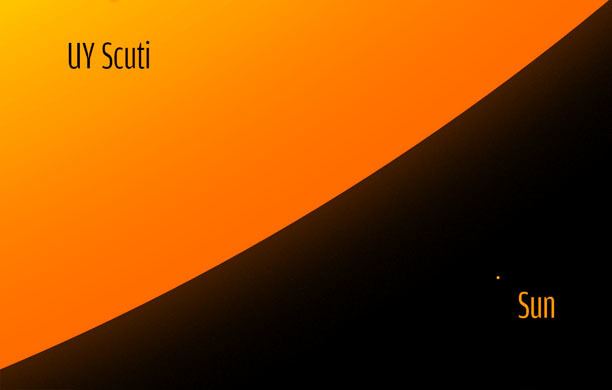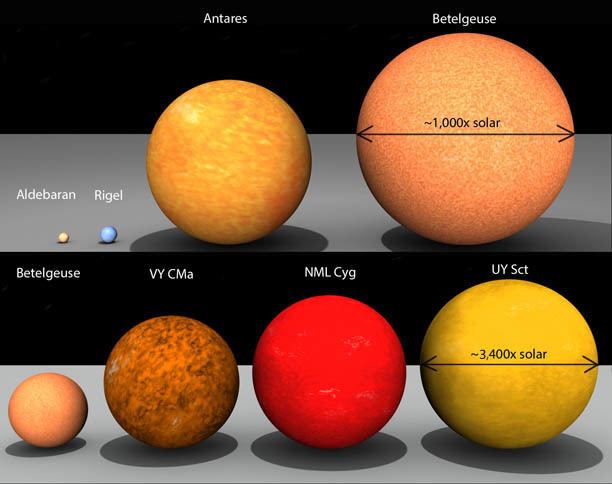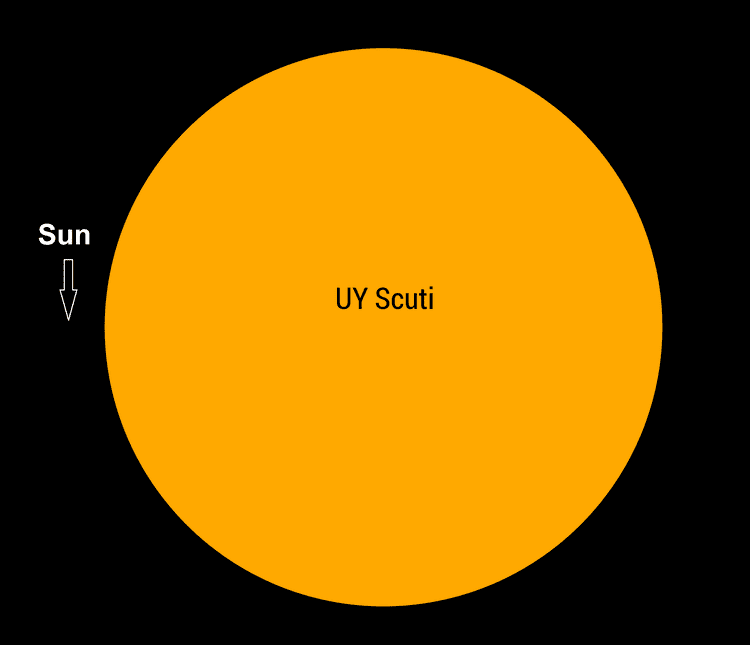Magnitude 11.2 Apparent magnitude (V) 11.2 | Constellation Scutum | |
 | ||
Similar | ||
Uy scuti biggest star in our galaxy universe sandbox 2
UY Scuti is a bright red supergiant and pulsating variable star in the constellation Scutum. It is a current and leading candidate for being the largest known star by radius and is also one of the most luminous of its kind. It has an estimated radius of 1,708 solar radii (1.188×109 kilometres; 7.94 astronomical units); thus a volume nearly 5 billion times that of the Sun. It is approximately 2.9 kiloparsecs (9,500 light-years) from Earth. If placed at the center of the Solar System, its photosphere would at least engulf the orbit of Jupiter.
Contents
- Uy scuti biggest star in our galaxy universe sandbox 2
- in hindi uy scuti largest star of the universe
- Nomenclature and history
- Characteristics
- Size
- Mass
- Supernova
- References

in hindi uy scuti largest star of the universe
Nomenclature and history

UY Scuti was first cataloged in 1860 by German astronomers at the Bonn Observatory during the first sky survey of stars for the Bonner Durchmusterung Stellar Catalogue. It was named BD -12 5055, the 5,055th star between 12°S and 13°S counting from 0h right ascension.

On the next detection of the star in the second survey it was found to have changed slightly in brightness, suggesting that it was a new variable star. In accordance with the international standard of designation of variable stars, it was called UY Scuti, the 38th variable star of the constellation Scutum (see variable star designation).

UY Scuti is located a few degrees north of the A-type star Gamma Scuti and northeast of the Eagle Nebula. Although the star is very luminous it is, at its brightest, only 9th magnitude as viewed from Earth, due to its distance and location in the Zone of Avoidance within the Cygnus rift.
Characteristics

The star is classified as a semiregular variable with an approximate pulsation period of 740 days. It has the total bolometric power of 340,000 L☉, making it one of the most luminous stars in the galaxy.

Despite its large size, UY Scuti is not classified as a hypergiant. There is an MKK luminosity class 0 (zero) for hypergiants, but this is rarely seen in published spectral classifications. More commonly, hypergiants are classed as Ia-0, Ia+, or even just Iae based solely on the observed spectra and red supergiants rarely receive these extra spectral classifications. A high luminosity and large size are insufficient for it to be defined as a hypergiant. That requires the detection of the spectral signatures of atmospheric instability and high mass loss. In the case of UY Scuti, its spectrum has the presence of spectral lines of carbon, water, and silicon oxide, but it does not show any spectral lines of oxygen, neon, and other heavier elements, indication of an insufficient mass loss rate. Furthermore, its location in the Hertzsprung–Russell diagram is below the oval region of hypergiants, making it only classified as a bright-red supergiant.
Size
In the summer of 2012, astronomers from the Very Large Telescope in the Atacama Desert in Chile measured the parameters of three supergiants near the Galactic Center region: UY Scuti, AH Scorpii, and KW Sagittarii. They determined that all three stars are over 1,000 times bigger than the Sun, making them some of the largest stars known. The stars' sizes were defined using the Rosseland Radius, the location at which the optical depth is 2/3.
UY Scuti was found to be the largest of the three stars measured, at 1,708 ± 192 R☉. This makes the star's radius the largest of any star and approximately 1.925 times the size of Betelgeuse.
A hypothetical object travelling at the speed of light would take about seven hours to travel around UY Scuti, whereas it would take 14.5 seconds to circle the Sun.
Mass
UY Scuti's mass is also uncertain, primarily because it has no visible companion star by which its mass can be measured through gravitational interference. Stellar evolutionary models conclude that the initial mass of a star (the mass of a star when it is formed) reaching the red supergiant stage like UY Scuti would have been around 25 M☉ (possibly up to 40 M☉ for a non-rotating star), and has probably lost more than half of that.
Supernova
Based on current models of stellar evolution, UY Scuti has begun to fuse helium and continues to fuse hydrogen in a shell around the core. The location of UY Scuti deep within the Milky Way disc suggests that it is a metal-rich star.
UY Scuti should fuse lithium, carbon, oxygen, neon, and silicon in its core within the next million years. After this, its core will begin to produce iron, disrupting the balance of gravity and radiation in its core and resulting in a core collapse supernova. It is expected that stars like UY Scuti should evolve back to hotter temperatures to become a yellow hypergiant, luminous blue variable, or a Wolf–Rayet star, creating a strong stellar wind that will eject its outer layers and expose the core, before exploding as a type IIb, IIn, or type Ib/Ic supernova.
